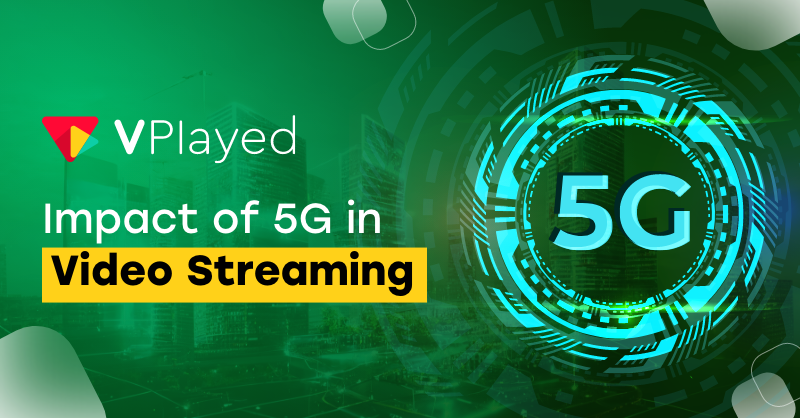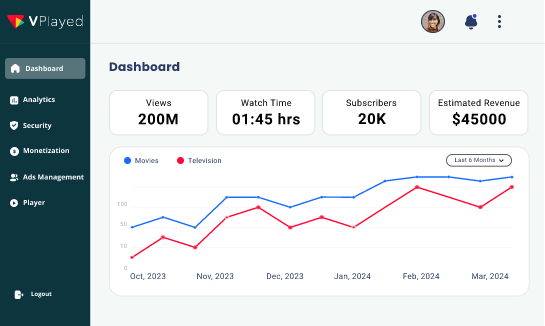Impact of 5G in Video Streaming

Table of Contents
Introduction
When considering cellular technology, each succeeding generation improves and enhances the strengths of the one that came before it. Starting with the origination of 1G and culminating in the widespread use of 4G, we have experienced an extraordinary evolutionary path.
Yet today, the focus of the world is squarely on the 5G technology – the fifth iteration of mobile networks – and its extensive repercussions for the global economy.
Unlike its predecessors, the 5G network surpasses the capabilities of the 4G in unprecedented ways. With a dense, distributed-access architecture, it enables lightning-fast data processing, revolutionizing the way we connect and communicate.
Yet, the 5G network’s impact extends far beyond speed and connectivity. It’s a game-changing force for the global economy. By harnessing the true potential of machine-learning-enabled automation, the 5G network elevates digital experiences, consequently catalyzing transformation across various industries and markets.
What is 5G Network?
5G is the fifth generation of mobile networks. Unlike its predecessors, 5G aims to deliver a more reliable and consistent user experience. One of the standout features of 5G is its remarkable peak speed, boasting up to 20 Gbps, making it a game-changer for professionals, especially broadcasters who rely on buffer-free video streaming.
Apart from its impressive speed, 5G brings a substantial reduction in latency, ensuring that the data travels with minimal delay. However, what distinguishes 5G from older generations is its remarkable connectivity standards, accommodating more network devices in an area without significant performance compromises.
What Is The Difference Between 4G and 5G?
At the network level, one can say that there is a notable distinction between 4G and 5G networks. Fundamentally, 4G functions on a centralized and hierarchical network architecture, where data processing and distribution take place at a central core.
In contrast to that, 5G introduces a more decentralized approach with edge computing. This means that the data processing and storage are moved closer to the network’s edge, thereby reducing the overall distance that data needs to travel.
Today, 73 countries around the world have 5G with the USA leading the league with the most 5G cities. To understand more, we have given a tabular comparison that provides a clear snapshot of how the 5G network surpasses 4G in various key aspects.
Feature |
4G |
5G |
|
Speed |
Peak speeds up to 1 Gbps |
Peak speeds up to 20 Gbps |
|
Latency |
Typically 30-50 milliseconds (ms) |
As low as 1 millisecond (ms) |
|
Connection Density |
Supports around 1,000 devices per km² |
Supports up to 1,000,000 devices per km² |
|
Use Cases |
Mobile broadband, streaming, basic IoT |
Enhanced mobile broadband, IoT, AR/VR |
|
Network Architecture |
Centralized, hierarchical |
Decentralized, edge computing |
|
Technology |
LTE-based |
Advanced technologies like mmWave |
|
Energy Efficiency |
Less efficient |
More energy-efficient |
|
Deployment |
Widespread |
Expanding |
Impact Of 5G Globally
Undoubtedly, the global influence of 5G is undeniable, as nations worldwide hasten to implement this revolutionary technology. Leading the charge in 5G adoption, South Korea boasts more than 23 million 5G subscriptions, representing a significant majority of its total mobile subscriptions, at over 60%.
China, with its aggressive rollout plans, is another frontrunner, boasting an extensive 5G network with over 700 million active connections that spanned across its major cities. The United States is also actively implementing 5G, with over 503 cities. Yes! You read that right.
Nevertheless, the expansion of 5G is poised to impact a wide array of sectors, from healthcare to transportation and entertainment. The technology’s potential to enable seamless connectivity, augmented reality, and IoT applications had ignited a global race to harness its capabilities.
5G Adoption In Key Countries – A Global Perspective
Today, 73 countries around the world have 5G with the USA leading the league with the most 5G cities.
With the use of 5G, we’ll have
- Great network capacity
- High data transfer rates
- Faster uploads & downloads
- Less buffering
- HD streaming of 4K videos
In this section, we will explore the rapid adoption of 5G in five countries: India, US, UK, Canada, and Australia. We will assess the extent of its coverage and the government’s initiatives aimed at further improving network performance and coverage.
(i) India
In 2022, India experienced its first taste of 5G technology. However, the mass adoption of 5G in India faces challenges due to inconsistent network coverage and the limited availability of affordable 5G handsets. A recent report by Counterpoint Research shed light on these hurdles.
To overcome these challenges, the Indian government is actively engaging with leading mobile phone manufacturers to encourage the prioritization of software upgrades that can support 5G networks. This collaboration seeks to expand the accessibility of 5G services to the audience.
The integration of 5G in India holds significant promise for various sectors. As this technology continues to advance, it is poised to usher in substantial transformations in the way both small-scale businesses and large corporations, as well as individuals, connect, communicate, and carry out their daily operations.
(ii) United States (US)
In the US, the impact of 5G on the economy is nothing short of substantial. It is estimated that the 5G economy has already contributed between $1.4 trillion to $1.7 trillion in U.S. economic growth. The country is actively pursuing 5G technology to revolutionize various industries, from healthcare to education and beyond.
Both the government & private firms are making significant investments in 5G R&D aiming to enhance network speed. Notably, compared to other nations, the US is excelling in the allocation of high-band and low-band spectrum for 5G, ensuring a robust 5G network foundation.
(iii) United Kingdom (UK)
The United Kingdom is rapidly welcoming 5G, with numerous trials and deployments underway. Several companies have already launched 5G services in the UK, and it’s now available to over 50% of the population, with plans to extend coverage to the entire country by 2028.
The government has allocated spectrum for 5G and is providing funding for research and development in this field. With an ambitious goal to deliver high-quality 5G to all populated areas by 2030, all four major UK mobile networks have rolled out 5G services.
(iv) Canada
In Canada, 5G has rapidly expanded its coverage, now reaching over 70% of the country. The government has not only made significant strides in 5G infrastructure but has also announced initiatives to support the development of 5G-based applications and services.
This rollout is projected to have a significant economic impact, with Western Canada anticipating an estimated annual increase in GDP of $34 billion by 2035, benefiting various industries. The introduction of 5G is forecasted to enable real GDP growth in Canada of $30 billion to $50 billion by 2030 and $100 billion to $120 billion by 2036.
(v) Australia
In Australia, the reach of the 5G network is continually expanding, and telcos are actively using mmWave networks, operating at extremely high frequencies, starting from 26GHz. The capabilities of 5G are generating excitement, as the ongoing rollout unlocks numerous opportunities for key industries and the broader Australian community.
While there is still work to be done in terms of business readiness for 5G in various sectors, encouraging more businesses to adopt 5G and utilize 5G-enabled technology promises numerous advantages for both industries and the overall economy. All in all, Australia’s journey with 5G is poised for continued growth and innovation.
How Can Streaming Players Leverage 5G?
5G has opened the doors to a new era of OTT streaming.
With high network capacity and rapid data transfer, OTT platforms can offer users seamless 8K streaming, eliminating buffering woes. This translates to happier and more engaged viewers. And additional revenue for the platforms.
While the increase of subscribers will be done on one side, these are what OTT & VOD platforms can deliver to provide entertainment around the clock:
- Deliver UHD videos to all devices
- Explore interactive video formats
- Achieve ultra-low live streaming latency
- Expand mobile app viewership
- Provide immersive AR/VR experiences
- Boost video speed and delivery by 10X
Bottomline
To conclude, the global video market is all set to skyrocket in video consumption with the coming of 5G and the same would impact the future of the streaming market and trends in large numbers. And, this ultimately would result in spiking demand for streaming content across the OTT landscape, ultimately leading video businesses across verticals to grow at scale—both revenue and engagement wise.
With the penetration of 5G, want to launch your own video streaming apps for more viewership & revenue?
